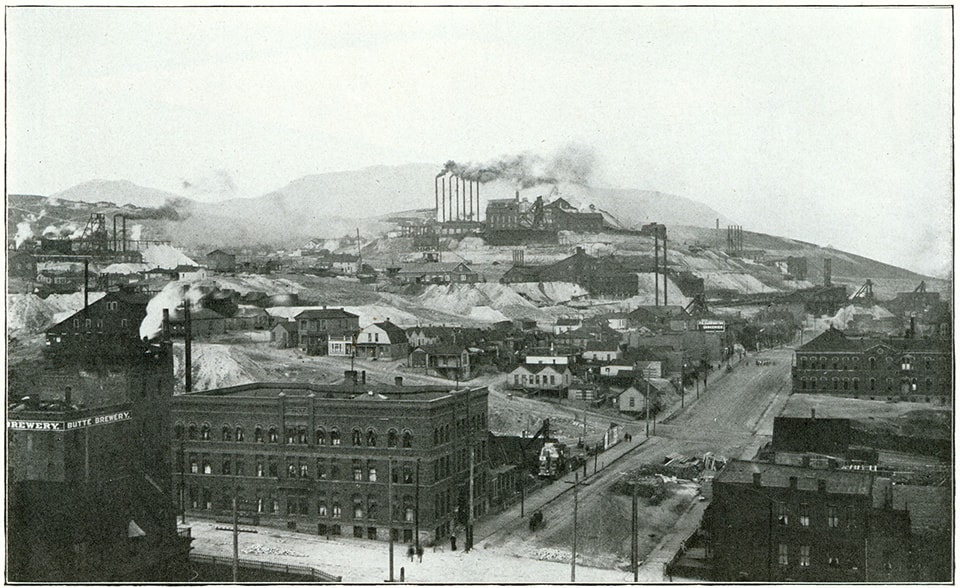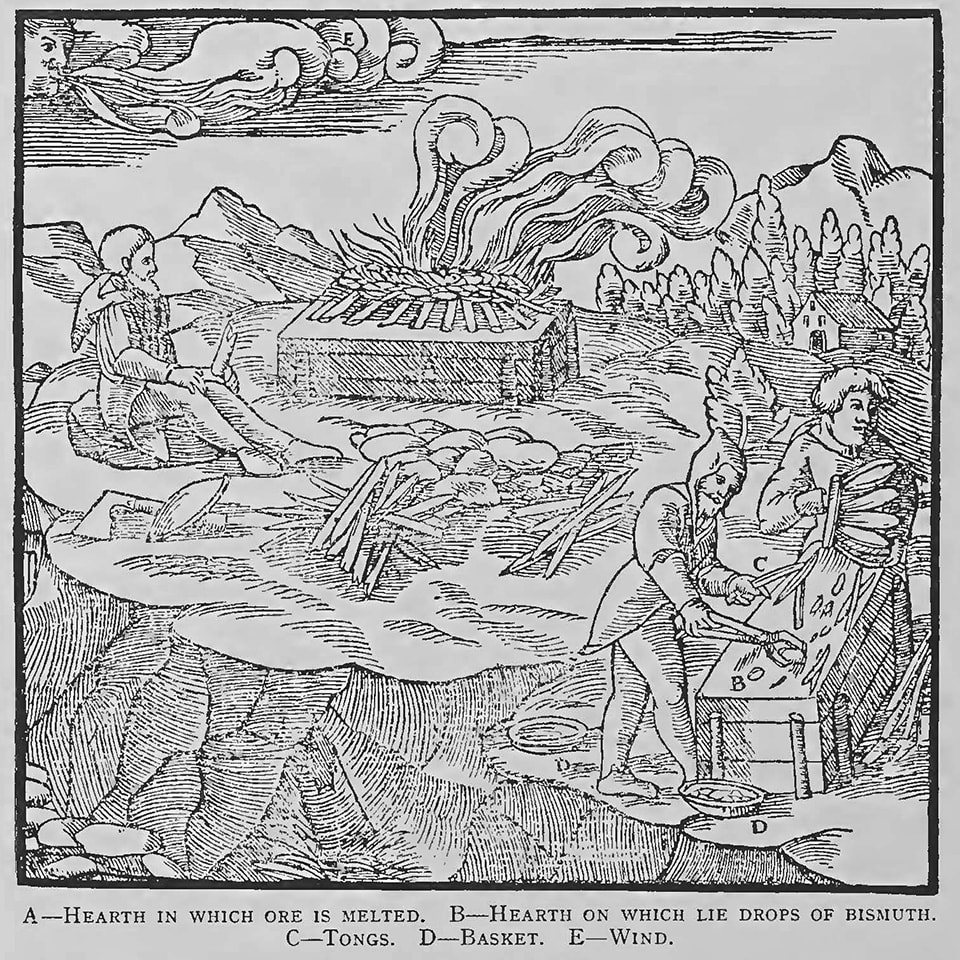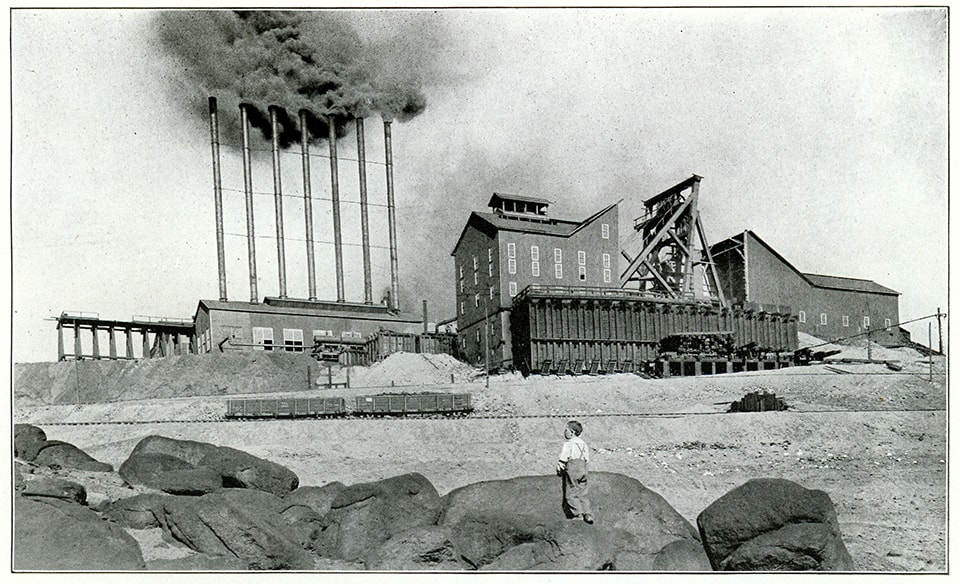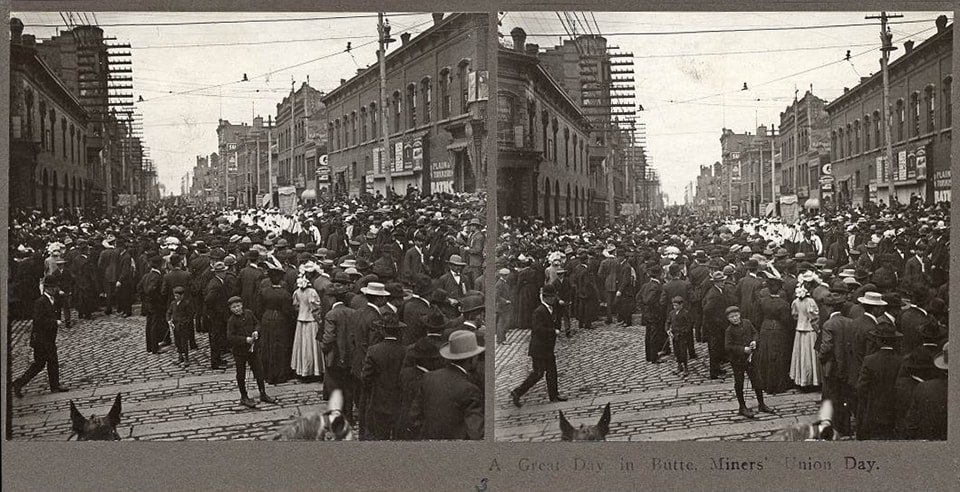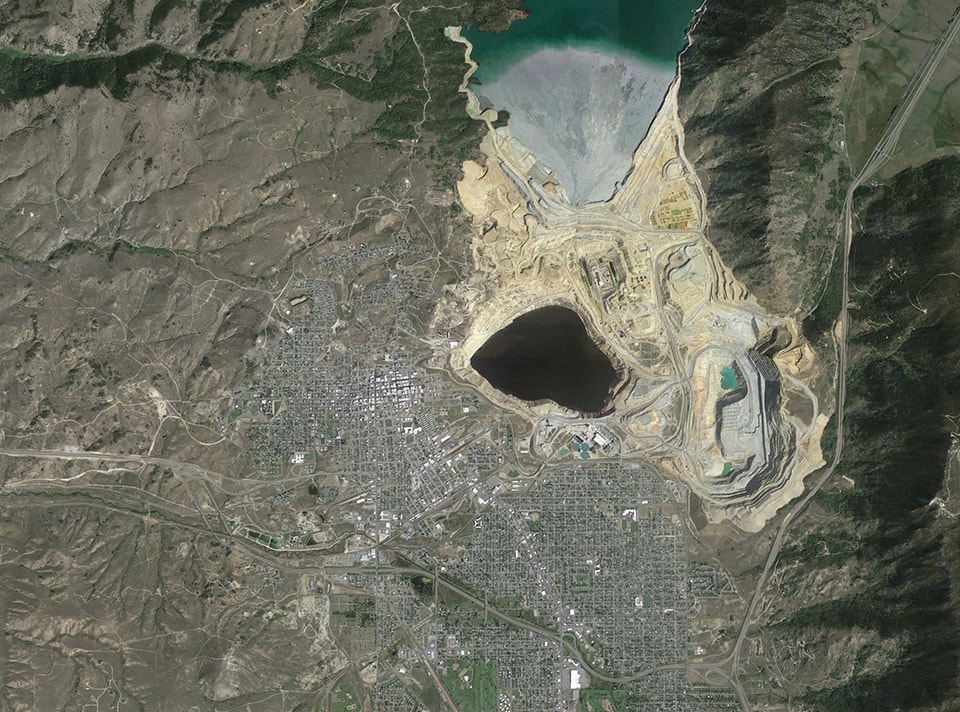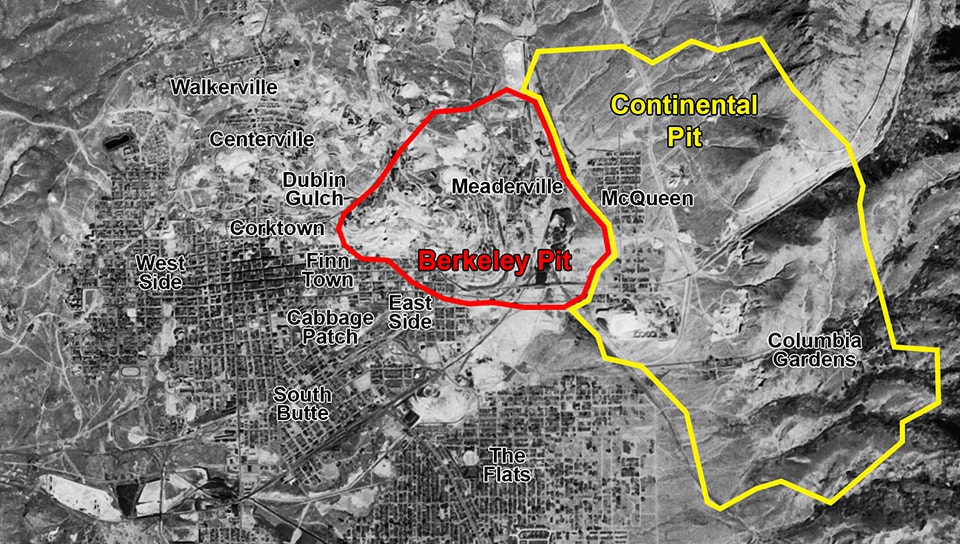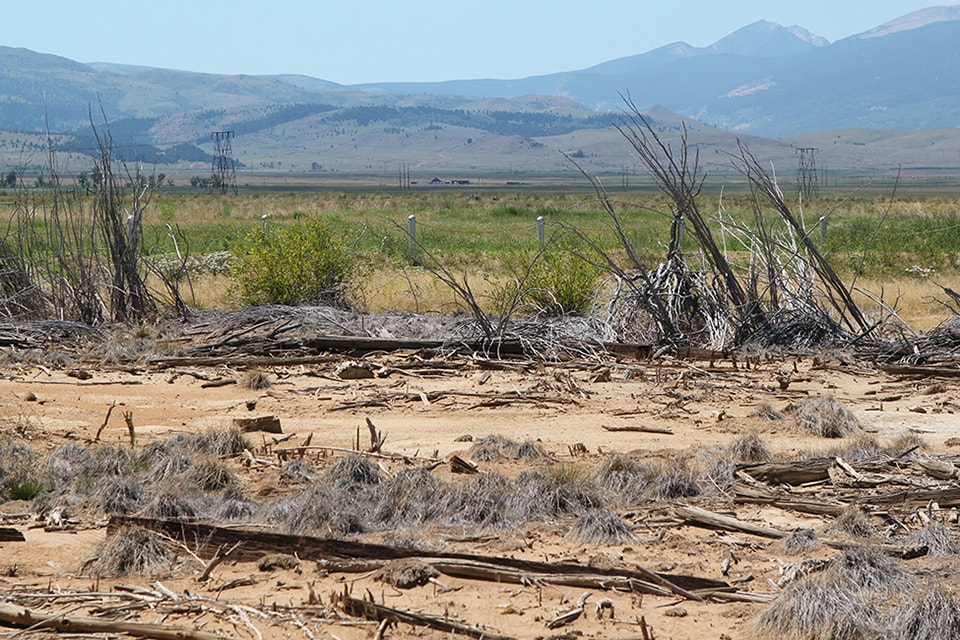“…and here was a scene so dreadfully hideous, so intolerably bleak and forlorn that it reduced the whole aspiration of man to a macabre and depressing joke. Here was wealth beyond computation, almost beyond imagination — and here were human habitations so abominable that they would have disgraced a race of alley cats.” [1]
– H. L. Mencken, The Libido for the Ugly
Simply put, extraction is an ugly process; both in physical form and its metropolitan externalities. Still, the vast resources present beneath us and the motivation to pull them to the surface are intimately tied to the settlement and permanent occupation of the landscape. At the start of the 20th century, the conditions H. L. Mencken describes were typical for many extraction-based mining towns and industrial regions around the country, although he did state that this particular instance in Pennsylvania was the ugliest place on earth he had ever seen. In many ways the physical conditions in the mining town of Butte, Montana at the time were likely not much better. There are few examples anywhere else in the world that showcase the collision of unimaginable wealth and the metropolitan implications of mass extraction better than Butte.
Figure 1. Famous “Anaconda Hill,” showing mines of the Parrot lode, the scene of early-day mining. (Butte Silver-Bow Public Library)
Butte, America, as it was known by many residents, was a world-renowned destination for mining, located in western Montana at approximately 5,538 ft. above sea level, atop the Boulder Batholith. The copper and gold veining which cross the Butte district in an east-west manner are contained within this host rock. These veins are the product of geologic processes along the Northern Rocky fault lines that generated an ore body that is 25 miles wide and 70 miles long and extends deep into the earth [2]. The ore veins of the region can stretch over 12,000 feet, have a vertical continuity of over 4,500 feet, and have mining widths approaching 50 feet. The subsurface resources available within the Butte Mining District have yet to be exhausted, and allow Butte to be still called the “Richest Hill on Earth” [3]. It is this richness and depth of resources that contributed to the construction of a complex network of shaft mines that extend over a mile deep to reach the ore. Approximately 49 miles of vertical shafts and 10,000 miles of horizontal workings exist under the Butte Hill (including much of the historic uptown) as miners followed the veins of valuable materials prior to the conversion to open pit mining [4]. It was the existence of this vast mineral resource, in this particular place of the intermountain west in the late 1800s, that set the stage for Butte to become the extraction metropolis par excellence.
Myth of Mining
From the earliest days of mining in Butte, the enormity of both the resources and the processes conceived to extract them, had a range of transformative impacts on the surrounding region. The drive to fuel smelters and shore up mine shafts had removed every combustible stick in the valley. The rampant deforestation was further exacerbated by the total botanic suppression caused by air pollution from the smelters and the deposition of inhospitable waste rock strewn across the Butte Hill. By 1900, the rocky landscape of the Silver Bow Creek Valley had become barren, riddled with heaps and holes, and stained by air and water that teemed with an array of toxic metals.
This relationship between mining and the surrounding landscape has been a topic of discussion for as long as mining has been an organized industry. In 1556 Georgius Agricola released De Re Metallica, the most comprehensive how-to guide for locating, mining, assaying, and processing of metals ever written. In this text, Agricola addresses many of the challenges associated with the mining of metals and methodically refutes any and all critique of the process. When discussing the role of mining in transforming the landscape, the text remarks:
[A]s the miners dig almost exclusively in mountains otherwise unproductive, and in valleys invested in gloom, they do either slight damage to the fields or none at all. Lastly, where woods and glades are cut down, they may be sown with grain after they have been cleared from the roots of shrubs and trees. These new fields soon produce rich crops, so that they repair the losses which the inhabitants suffer from increased cost of timber. Moreover, with the metals which are melted from the ore, birds without number, edible beasts and fish can be purchased elsewhere and brought to these mountainous regions. [5]
Figure 2. Plate from Book 9 of De Re Metallica. (Project Gutenberg)
The intricate woodcuts produced for the volume show landscapes sprinkled with cottages, trees, and distant mountains. A figure from Book 9 (fig. 2) shows a process of smelting ore with the wind both helping to stoke the fire and also cleanly ‘sweeping away’ the resultant toxic smoke. A quick comparison with photos of Butte suggest a different story (fig. 3). The idealistic relationship between mining and the surficial landscape that Agricola describes did not exist in practice. For here in Butte we see a rather less romantic young child whose playground is a waste rock pile draped in a thick smog from the 24-hour processing of metal.
Figure 3. Neversweat Mine – Butte, Montana 1900. (Butte Silver-Bow Public Library)
Work and Wealth
At the turn of the century, it was the presence of valuable metals and the intensity of geologic extraction alone that encouraged settlement in this remote location. Settlers came to the region looking to “strike it rich” through mining. This idea of instant fortune through mining marked a profound turn in labor. In Technics and Civilization, Lewis Mumford describes the transition from forms of labor such as farming or herding, to that of mining and industry. In the case of the former, there was a proportional relationship between labor and profit, where the drive to cultivate additional crops or raise larger herds of livestock translated into more work, but more pay. In the early years of mining, neither technical skill nor great effort was required for a miner to reap great fortune. Luck appeared to be the primary decider of profit [6]. The lifestyle and culture supported by such rich mining communities — highly competitive, lucrative, and employing high percentages of the population — had a significant and formative impact on the towns themselves. Mumford describes what he calls the “slatternly disorder” of the mining town as a product of the brutalizing conditions in which the miners worked. It could be assumed that in addition to the working conditions of the miners, the underlying possibility of becoming rich overnight and the gamble associated with this desire only perpetuated Mumford’s “disorder”.
Similarly, for planner Benton MacKaye (who maintained a rather transcendental, binary view of the relationship between the developed and the natural world), the ills of industrial development were evident. He argued for an ideal form of living that he called “Play,” which amounted to the inseparable combination of toil and leisure [7]. The opposite of this, the condition found in most industrial or “over-civilized” situations — the mining town, for example — is one that has segregated and reduced both work and leisure to “mechanized” products. In the case of both Mumford and MacKaye, the society generated through the process of work was one of extreme polarization, with wealth on one side and exploitation of the worker on the other. Butte embodied this condition, as Edwin Dobbs reminds us “This was a place where work was everything” [8]. People came to Butte for work. With this mechanized system of work came a mechanized system of leisure. Consider, for instance, the saloon and the brothel — hyper-managed constructs designed to accommodate a type of routine leisure favored by the overly-masculine masses. This “over-civilization” (mechanized and segregated work and leisure) taking the physical form of “slatternly disorder” was a common occurrence in many mining and industrial communities. While it clearly did possess its share of hedonism and vice, it became clear by the early 1900s that Butte was a different type of mining community. Butte called into question the generalizations of both Mumford and MacKaye by growing into a unique industrial town whose uncharacteristically rich social development was fueled by what appeared to be an unlimited quantity of valuable metals.
The Idiosyncrasies of Butte
It was not long after the mining boom of Butte that the state of Montana began calling itself the “Treasure State” and using the motto “Oro y Plata” (Gold and Silver) on the State Seal. The economics of Butte have always been tied to resource extraction. Mining began with gold, but quickly shifted to copper as the country’s growth and need for electricity fueled a round-the-clock extraction, with Butte producing 30% of the nation’s copper in 1920, and placed the mining town, with its $55 million dollar annual income, at number five on the state list of revenue [9]. Butte’s material was of such importance to the American war effort that after the bombing of the Miner’s Union Hall in 1914 and the subsequent labor strikes resulting from the Granite Mountain Fire, martial law was instated to ensure continuous production. It lasted through 1921, the longest period of military occupation in the U.S. since the Reconstruction era. During war times, striking miners were accused of treason, and were escorted to work at gunpoint in order to support the war effort [10].
The draw of wealth was so great that immigrants were often instructed, “Don’t stop in America, go straight to Butte!” The strong attraction of Butte encouraged the development of a formidable community, both physically and socially. In 1890, Butte was one of the most culturally diverse cities in the country, with foreign-born residents exceeding 45% of the population [11]. Strong formal enclaves of Chinese, Cornish, Scandinavians, Lebanese and the largest population per capita of Irish in the U.S. existed within the city. In 1900, there were approximately 40,000 people living on the Butte Hill, and by 1920 that number had ballooned to nearly 90,000. The mining town was becoming a city. The mining industry was even facilitating the creation of large pieces of civic infrastructure. In 1899, copper baron William A Clark purchased 21 acres and invested one million of his own dollars to construct the Columbia Gardens Amusement Park, an oasis of green created in the barren landscape of extraction, for the enjoyment of residents of Butte.
Despite these efforts at civility or the establishment of a cosmopolitan lifestyle, Butte’s inseparable ties to mining caused it to struggle with a bifurcated identity. After less than 20 years of mining activity, the settlement had over 200 saloons and by 1900, 85% of its population was under the age of 25. Journalist Ray Stannard Baker said of Butte “It gives one the impression of an overgrown mining camp awakened suddenly to the consciousness that it is a city, putting on the airs and properties of the city, and yet often relapsing into the old, fascinating, reckless life of a frontier camp” [12]. It was this two-faced existence that made Butte such a unique place. Butte possessed many of the qualities of contemporary highly “civilized” cities, while remaining linked to the resources and lifestyle that led to its success. (Fig. 4) Most importantly, these two realities occurred on top of one another, at the same point in time.
In his keynote address to the Vernacular Architectural Forum Symposium in 2010 Edwin Dobbs describes this duality of existence through the lens of his childhood growing up in Butte:
We found the place to be endlessly rich and stimulating, a thousand times more interesting than the fakery of a Disneyland.
One of my early playgrounds was a stretch of mine waste bordered by a stream that ran orange and yellow. We called it Shit Creek. Today, it’s the site of the concentrator, where ore bearing small amounts of copper and molybdenum is prepared for smelting. Another playground, when I visited my older cousins on the Hill, was the Steward Mine. We played there while the mine operated. It helped to be lucky. It also helped to be able to run fast and scale fences quickly. I could cite more examples: The red light district, for instance, was located only a couple blocks from my high school. We routinely walked past working brothels to get to the stores and soda fountains uptown. Or maybe to one of the bars that served teenagers — another way in which what might be considered transgressive elsewhere was tolerated in Butte. [13]
Figure 4. Circa 1910 stereograph view of the Miners’ Union Day festivities in Butte, by N.A. Forsyth. (Montana Historical Society Photograph Archives)
Extraction in Butte Today
Present-day Butte is the physical manifestation of over 100 years of continuous mining. Its streets come with names like Platinum, Gold, Silver and Granite — just in case you missed the giant craters (the Berkeley and Continental Pits) on the northeastern edge of town (Fig. 5) — and remind you of the geologic underpinnings of this settlement. At one point, there were at least 200 mine shafts puncturing the urban surface and integrated into the fabric of the city. The overburden from these shafts was scattered about the town and to this day has a significant role in shaping the city [14]. In 1912, Walter Harvey Weed wrote, “Heaps of waste are everywhere prominent, attesting by their great size the extent of the underground workings” [15]. Today over 660 million metric tons of waste rock are spread across the 25 square mile surface of the former Butte Hill.
Figure 5. Aerial Photograph of Butte, Montana 2014. (Google Earth)
As mining techniques became more efficient and metal prices dropped, the process of mining became less and less integrated with the city itself, even though the operation never completely ceased. In the 1950s, when open-pit mining became the primary extraction method, the city transformed from a community spatially entwined with mining to one that was simply adjacent to a mining operation. The waste rock that had once contoured the city was now hauled to one location, creating an impoundment for the tailings generated by the processing of ore. At the turn of the last century, over 45 mining companies and almost 18,000 miners in 34 different labor unions were working the Hill. Today there is one active mining operation — Montana Resources at the Continental Pit, with approximately 350 employees — and the city has shifted from mineral extraction to tourism and festivals as the basis of its new economy.
Conflicting Legacies
Today, Butte is a community showcasing its extraction past. And while its status as the largest national historic landmark district in the country is well deserved, so is its status as the largest Superfund site in the nation. Enamored with its storied past, all things in Butte point backward, with very little attention going to imagining how this legacy translates into a novel future for a community that will continue to rely on extraction for its well-being. One exception is Dobb’s speculation that the tremendous environmental problems associated with Butte provide it with a kind of ‘shield’ that makes it problematic and less attractive than the other, more rapidly developing areas of Montana (e.g. Bozeman), that have become characterized by ubiquitous sprawl. Relying on this protection alone, however, only assures that Butte’s future will look like its past.
While a place like Butte spends a good deal of time looking backward, there are examples of contemporary mining communities that lack this nostalgia. Examples of such settlements are becoming ever more present in places associated with hydraulic oil fracturing such as North Dakota and Pennsylvania. Large territories of subsurface oil and gas have led to the creation of mono-purpose settlements that either spring from the ground or very effectively gentrify existing communities. The present-day mining community — unhindered by historical baggage — does exist, and it appears socially and culturally abhorrent. These places lack many of the qualities that we would associate with a livable settlement, particularly considering that the vast majority of the time spent in these locations is associated with work. The 8-hour days so bitterly fought for in Butte have been replaced by 24-hour shifts with larger gaps of “free” time. However, leisure does not typically exist here, and time off is typically spent in consolidated chunks with family and friends in other locations, not within the community itself. This condition of sessional or seasonal employment is quite different from that of Butte, where it was necessary and advantageous to provide all levels of leisure to a community that was less mobile and more tied to place, where the hedonism of saloons and brothels was tempered by ballroom dancing, musicals, softball leagues and picnics at the decadent and highly prized Columbia Gardens.
Because of the seemingly endless lode of materials beneath the city, speculations to expand operations, or even restart underground mining, have been part of a more recent history and present day conversation. In 1972 the Butte Regional/Urban Design Assistance Team, which included representatives from the American Institute of Architects and local professionals, proposed to move the residents and historic structures from the top of the hill down into the valley in order to expand the Berkeley Pit westward into what is now the historic uptown of Butte. City council ultimately halted the plan in 1976 [16]. This proposal seems audacious, but it is not unprecedented: just last year, a design competition was held to solicit strategies to pick up and move the city of Kiruna, Sweden so that mining companies could continue mining iron ore deposits that extend beneath the 6,000 year old Sami settlement. This transparent and participatory effort in Sweden is being funded by the state-owned mining company, which seems much more democratic than the historic fate of large sections of Butte (including the Columbia Gardens) that were mysteriously burned and eventually swallowed by the Pit — a literal extraction of a metropolis (Fig. 6).
Figure 6. Map of Butte, Montana Prior to Open Pit Mines. (1954 USGS Aerial Photograph, overlay by Authors)
Few communities possessed (and still possess) the charm and grit of Butte. Most extraction settlements faced one of two possible fates. Many of these so-called “boomtowns” simply disappeared with the cessation of extraction and/or material processing; Belleville, California serves as an example of this fate. However, several boomtowns did hold on to a small percentage of their populations and now exist within an economy based entirely on tourism (Virginia City, Nevada, Deadwood, South Dakota or Tombstone, Arizona, for example). Another scenario for these extraction communities is for their eventual transition into more developed metropolises through the establishment of an economy no longer tied to mining. While few boomtowns were fortunate enough to be located in places where this was an option, Denver, Colorado clearly shows that it was possible.
Butte is uncommon among the cohort of “boomtowns” that went bust or redefined themselves within a new economy. In Butte, extraction is still a significant component of the community and its economy. While the mining industry does not employ the same percentage of the population as it used to, other industries such as education, healthcare, transport and manufacturing have filled in some of the gaps. The most significant contributor to the new economy is the exploitation of the historic past in tourism and festivals that rely on nostalgia, trapping Butte in a period defined by the Historic Landmark designation. This overlay is so significant that there are contaminated landscapes of tailings (Fig. 7) and channel walls for the creek that are made of smelter slag, included as part of this historically-designated fabric.
Figure 7. Tailings Observation Area east of Anaconda, Montana identified by bollards and gold chain to separate reclaimed land from the historically-designated waste site, 2013. (Photograph by Authors)
Reclamation of the Butte Hill is similar to that of many sites where the EPA standards and the state laws governing hard rock mining reclamation dictate an attempt to return the landscape to its “pre-mining condition.” This process has made the Butte Hill uninhabitable in a new way. The waste-left-in-place cap has created a fragile and uninhabitable prairie segregating many parts of the community once connected by mining (Fig 8). One can only imagine what the city of Butte would look like today had the sorting of the waste rock from mining not been based on efficiency, but rather on a conscious decision of beneficial place making.
Figure 8. Missoula Gulch Reclamation Site, Butte, Montana 2014. (Photograph by Authors)
The Mining Metropolis of the Future
The days of extraction are not only behind us as objects of reflection, but ahead of us as opportunistic conditions as well. We are entering a new technological era of resource extraction that allows us to process materials with smaller percentages of desired elements. As we reprocess or re-extract existing waste (e.g. landfill mining or the reprocessing of mine waste), or extract resources previously unavailable (e.g. hydraulic fracturing), we are still left with a significant residue of unusable and often toxic material. Even as technology evolves, the throughput of raw material typically remains very high, leading us back to many of the lessons learned from Butte.
Using Butte as a case study gives us the unique opportunity to speculate on how the future of the mining metropolis might unfold, and just how planning efforts might engage it. To do this, we lay out a series of strategies that could be beneficial when considering cities and communities (both present and future) that rely on extraction. It is evident that we will explore new territories for the sourcing of raw materials, as well as re-visit old ones. The proposed strategies seek to provoke a mutualistic inhabitation of these landscapes and provide opportunities for sustained communities, not simply boomtowns that exploit and abandon.
First, a central theme is the adjacency of material extraction to the community itself. By working diligently to promote a strong awareness of the process of extraction itself, new forms of understanding and appreciation are certainly possible. This trajectory is not dissimilar to the Farm to Table movement or other such agendas to reconnect product source and destination as a critical reaction to global-scale industry. Contextualizing the relationship of resource extraction and place creates opportunities for authentic engagement with the processes that provide the resources in our daily lives. It is not difficult to fathom a future where “local copper” or “heirloom metals” are actual items of desire.
Second, while there is a well-established tourism industry in the Intermountain West for precisely these types of places, it predictably focuses on the past. The tourism is predicated on only remembering “the good times” and downplays or ignores the social struggle and environmental impact that these extractive settlements truly embodied. Similarly, modern resource extraction is typically hidden from public view, or situated in remote locations. The monumental scale and infrastructure required by the extraction industry should be coupled with the creation of a new economy that can leverage the existing tourism market without the need of nostalgia. The roles of view, access, and experience should be re-calibrated to showcase these places as the evolving product of a process, and not a historic event simply to be remembered. The goal is to illuminate the urban role in the industrial process, as opposed to merely the distilled products of that process.
Lastly, if mining settlements have taught us anything it would be that staking the wellbeing of a community entirely to a singular resource or product creates a tremendous amount of vulnerability, leading typically to collapse. The presumed outcome of all the labor, money and energy that goes into extraction should not be focused on just the singular and irresponsible production of concentrated ore. Future projects of industrial extraction should be systemically interwoven into a larger plan of social, ecological and financial resilience. The process of extraction should be held accountable for the actual creation of place instead of the destruction and eventual reclamation of it.
We do not intend to present every extraction community as permanent or stable. However, if the sorting and remaking of the land was imbued with an agenda of identity generation instead of mere efficiency, these highly disturbed places could take on a value beyond the residues of extraction. No resident, temporary or permanent, should live without challenge, inspiration and wonder from the environment around them. Advances in technology, environmental regulation and social justice are just beginning to open up large extraction industries to alternative forms of engagement. There is a prominent role for the designer in this equation. If we can engage these processes of excavation, sorting, and processing in creative and productive ways, the potential exists to turn what many see as a necessary and context-less evil into one of the most impactful and unique forms of place-making of our generation.
Figure 9. Berkeley Pit overlook. Butte, Montana 2015. (Photograph by Karen Lutsky)
 Bradford Watson is an Assistant Professor in the School of Architecture at Montana State University where he teaches Design Studios and Building Construction. He received a Bachelor of Architecture from Pennsylvania State University and a Masters of Architecture from Cranbrook Academy of Art. He is a licensed architect in the states of Montana and Ohio where he spent 12 years in professional practice with an emphasis on cultural and performing arts planning and design. His current research explores the implications of occupying the mountain west landscape through the lens of historic and present day extractive practices; specifically related to the issues surrounding reclamation from both material and experiential extraction.
Bradford Watson is an Assistant Professor in the School of Architecture at Montana State University where he teaches Design Studios and Building Construction. He received a Bachelor of Architecture from Pennsylvania State University and a Masters of Architecture from Cranbrook Academy of Art. He is a licensed architect in the states of Montana and Ohio where he spent 12 years in professional practice with an emphasis on cultural and performing arts planning and design. His current research explores the implications of occupying the mountain west landscape through the lens of historic and present day extractive practices; specifically related to the issues surrounding reclamation from both material and experiential extraction.
 Sean Burkholder is Assistant Professor of Landscape and Urban Design at the University at Buffalo. Sean’s research focuses on the agency of ecological processes in the re-consideration of transitional urban landscapes. A good deal of this work is applied to vacant land mitigation, post-industrial areas, and the large sites created through sediment management regimes within the Great Lakes Region. Sean has practiced professionally as designer and project manager at scales ranging from the urban region to architecture. This work, both academic and professional, looks to reconnect people to the inherent ecological processes at work within the urban environment, while concurrently leveraging the performative aspects of this relationship.
Sean Burkholder is Assistant Professor of Landscape and Urban Design at the University at Buffalo. Sean’s research focuses on the agency of ecological processes in the re-consideration of transitional urban landscapes. A good deal of this work is applied to vacant land mitigation, post-industrial areas, and the large sites created through sediment management regimes within the Great Lakes Region. Sean has practiced professionally as designer and project manager at scales ranging from the urban region to architecture. This work, both academic and professional, looks to reconnect people to the inherent ecological processes at work within the urban environment, while concurrently leveraging the performative aspects of this relationship.
Notes:
[1] H. L.Mencken, “The Libido for the Ugly,” Prejudices: Sixth Series (New York: Alfred A. Knopf, 1927).
[2] Walter Harvey Weed, Geology and ore deposits of the Butte district, Montana (Washington: Government Printing Office, 1912).
[3] Steve J. Czehura, Butte, A World Class Ore Deposit, (Butte, MT: Montana Resources, LLP, 2006).
[4] Ted Duaime, Patrick Kennelly and Paul Thale, “Butte, Montana, Richest Hill on Earth; 100 Years of Underground Mining” [map], 2004, Montana Bureau of Mines and Geology Miscellaneous Contribution 19, scale 1:9,000.
[5] Georgious Agricola, De Re Metallica, trans. Herbert Clark Hoover (New York: Dover Publications, 1950), accessed January 20, 2015, http://www.gutenberg.org/files/38015/38015-h/38015-h.htm.
[6] Lewis Mumford, Technics and Civilization (New York: Harcourt, Brace and Co., 1934).
[7] Benton MacKaye, The New Exploration: A Philosophy of Regional Planning (New York: Harcourt, Brace and Co., 1928).
[8] Edwin Dobb, “Viewpoint: Location, Occupation, Juxtaposition, Interpenetration. Notes on an Erotic of the Mining City,” Buildings & Landscapes 17, no. 1 (2010).
[9] Harry Campbell Freeman, A Brief History of Butte, Montana, the World’s Greatest Mining Camp; Including a Story of the Extraction and Treatment of Ores from Its Gigantic Copper Properties (Chicago: H. O. Shepard Co., 1900).
[10] Butte, America [film], directed by Pamela Roberts (2009; Bozeman, MT: Rattlesnake Productions), Min. 22.
[11] Michael P. Malone, The Battle for Butte: Mining and Politics on the Northern Frontier, 1864-1906, (Helena, MT: Montana Historical Society Press, 1995).
[12] Ibid.
[13] Dobb.
[14] Bradford Watson and Sean Burkholder, “Charted Displacement, Butte Montana,” ON SITE review 31 (2014): 66-69.
[15] Weed.
[16] Richard L. Gibson, Lost Butte Montana (Charleston, SC: The History Press, 2012).

